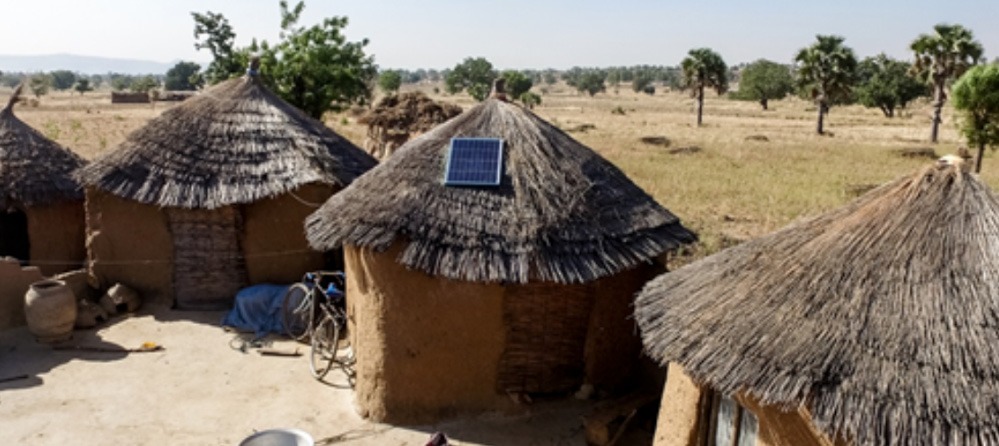Suddenly it turns dark in Maroua’s, North Cameroon, streets as the local dwellers are having their evening snack of roasted fish. It is another power failure, and the restaurant owners are busy pulling out their rechargeable lamps, candles and torches to once again brighten up their businesses. These power cuts disrupt the social and economic life of the inhabitants of this town and could be unbearable for some dwellers, based on the possibility of living in a total blackout.
“Power cuts are common in this town, and they can last for 4 hours,” said Evelyn, standing behind her mini barbecue on which she roasts fish every evening for a living. She added that the power outages trigger the fear of Boko Haram, which is still present around, affecting her business, but even in those conditions, she feels privileged compared to those who live in the surrounding rural areas.

A local girl studying at night

“Can you imagine living in a community which has never experienced electricity-produced light? There are several villages like that around here.” Confirmed Babah, a fish consumer, sitting on a wooden table in front of Evelyn’s barbecue.
Indeed, a few kilometres from Maroua, there are hundreds of villages that have never known any kind of electric illumination; this situation gravely affects education and health opportunities for the villagers.
Those off-grid communities are part of the population that UNESCO is targeting with renewable energy solutions as part of its project, funded by the India-UN Fund, to enable the use of renewable energy and energy-efficient technologies in households in the three communes of Bibemi, Poli and Zina in the North and Far North of Cameroon.
“If I could just have a light bulb in the middle of my dealership, I would be very grateful. This will help my children and my neighbours,” Mr. Adamou Hamadou, a father of eight children from a small village of Bibemi.
This project places women at the heart of the activities to promote renewable energy technologies since women are at the forefront of most energy consumption in households. They bear the enormous responsibility of finding firewood, fetching water, and looking after the house and the children. Thus, this project strengthens women’s capacities to become community leaders by teaching them different skills in the promotion of energy-efficient technologies.
In addition to the core training for the community representatives selected to become trainers, five other women, named “Solar Mamas”, gained expertise at Barefoot College in Dakar, Senegal, in the production of various renewable energies, all using locally available materials. Those women will become renewable energy champions for their communities.
Susan, 56, a widow and grandmother with nine children in Bikale on the outskirts of Bibemi, has revealed that she intends to expand her cheese and yogurt business once solar panels are installed in her home.
“I am so happy because my family will have a better life, since my children will be able to work at night and I will be able to produce and store yogurts more easily in the refrigerator,” she said, sharing her hopes.
Susan and seven of her children

Local women bringing firewood to the village
A group of women from Zina, returning from their regular chores of collecting wood, explained that if they could reduce the amount of wood needed for cooking through the use of improved stoves, then they would have more time to devote to other activities.
At the community level, the joy is evident as families eagerly await their dream of having electricity in their homes come true by December 2021 owing to this $1 million project. In the first phase of the project, the use of photovoltaic systems, improved stoves, ecological briquettes and the CM2013 bio-digesters would be popularized among 1,000 households (about 6,000 people), eventually benefiting 12,000 people by the end of 2021.
The project is implemented jointly with partners with complementary skills such as local NGOs and the Ecole Polytechnique de Maroua and also involves schools and communities in educational activities for sustainable energy solutions. According to Mr. Mohamadou Alidou of the National Advanced School
of Engineering of Maroua, “At the moment, Cameroon is facing a very serious problem of energy deficiency and this gets worse in the Northern part of Cameroon, so this project will enable us to use our natural energy potential, which is the sun. Renewable energy is at the heart of most development projects, justifying why the education sector is also supporting this project.”
Cameroon has significant potential in renewable energy sources, in particular with a large solar exposure and large biomass resources. Access to energy remains precarious, however, especially in rural areas. This precariousness is more severe in the regions of the North and the Far North, where the electrification rate is very low – less than 22 per cent – and where more than 95 per cent of households use wood fires for cooking.
Aware of the impact of the energy sector on the environment and on climate change, Cameroon has opted for sustainable development by planning to increase the share of renewable energy in its energy supply to 25 per cent by 2035. The proportion of the population with access to hydroelectric and thermal energy is less than 10 per cent and less than 1 per cent uses renewable energy, yet the country has significant potential in renewable energy sources, particularly in the North and Far North regions.
This project is seeking ways to promote the use of alternative energy sources such as solar, eco-friendly charcoal, sustainable stoves and biofuel production and contribute to Cameroon’s efforts to achieve SDG 7 by striving to reduce gaps in access to affordable energy and contributing to the vision of providing services for reliable and modern energy by 2030 in line with the 2030 Agenda.

Solar panel on thatched roof
Originally posted by the United Nations Office for South South Cooperation (UNOSSC). To read the original article, please click here.
